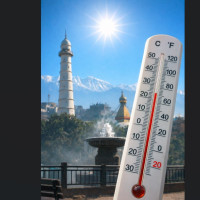- Saturday, 10 January 2026
Expedite Drive Against Dengue Virus
Dengue infection has emerged as one of the major public health challenges in Nepal for more than two decades. The country reports thousands of dengue cases every year. Though the dengue death toll still remains low, its outbreaks have posed a serious risk to people’s health. This deadly viral disease can also have a profound impact on their socio-economic condition as it affects patients, families and communities. Haphazard urbanisation, poor waste management system, climate change, growing migration, inadequate public health resources and low level of public awareness are some of the key factors behind the recurring dengue infections in the country.
Dengue is endemic in more than 100 countries, threatening the health of billions of people globally. As per the World Health Organisation (WHO), about half of the world's population is now at risk of dengue, with an estimated 100–400 million infections occurring each year. It mentions that while many dengue infections are asymptomatic or produce only mild illness, the virus can occasionally cause more severe cases, and even death.
Surge in infections
With the arrival of monsoon, hospitals in provinces like Koshi, Bagmati and Gandaki are reported to have begun reporting a considerable surge in the number of patients infected with dengue. Even the health facilities available in Kathmandu have recorded a gradual rise in the number of such patients in recent weeks. This trend may continue as the period between Asar (June-July) and Asoj (September-October) is considered the most suitable for dengue outbreaks in the country. However, dengue cases are detected in the country throughout the year with rising temperatures.
According to health authorities, nearly 1,700 dengue cases have been reported in 73 districts in the past six months. They say that the situation might worsen if the ongoing rains come to a halt for some days. The Epidemiology and Disease Control Division (EDCD), which is under the Department of Health Services, has projected that the country could see a worsening situation with an unprecedented increase in the number of dengue cases in the next three months or so. ECDC has warned that dengue cases may exceed 60,000 during the period if more effective preventive measures are not taken on time. This projection really points to an alarming scenario and calls for immediate, result-oriented action. If this prediction comes true, the dengue upsurge may even deal a severe blow to the sensitive tourism industry during its peak autumn season.
Last year, nearly 42,000 people were infected with the dengue virus, while the death toll stood at around 15. During that year, dengue infections spread in 76 districts. Virologists say the reported infections may make up just a small portion of the real scenario of dengue infections. According to them, nearly 90 per cent of those infected do not show any symptoms. The number of dengue cases detected in 2023 exceeded 52,000. Its death toll stood at 52. Sunsari district was heavily affected by the disease. The district accounted for about 31 per cent of the total number of confirmed cases.
For the first time in Nepal, dengue infections were reported in all seven provinces and 77 districts in 2022, with over 54,000 infections and 88 deaths. The Kathmandu Valley was also adversely affected by the viral disease during that year. The healthcare system was overwhelmed with patients infected with the virus. The valley’s cases accounted for more than 55 per cent of the total number of infections nationwide. So, the valley was even sarcastically dubbed as ‘Dengue Capital’ during that year.
Dengue infection is transmitted to humans when two mosquito species -- Aedes aegypti and Aedes albopictus -- bite them. Female mosquitoes of these species can become carriers after feeding on an infected person. Then, they can spread the virus to others through their bites. Dengue-spreading mosquitoes breed in clean water. They find it easier to breed in open objects such as water tanks, buckets, tyres, bottles and cups. They can also use ponds and potholes for breeding. Normally, these mosquitoes bite in daytime.
Sudden fever, severe headache, pain in muscles, joints and eyes, rashes and vomiting are common symptoms of dengue infection. Though no specific medicine has so far been developed for the treatment of this viral disease, health professionals advise everyone showing the aforementioned symptoms to visit a healthcare facility immediately. When the disease is diagnosed at its early stage, it may become easier for the infected to recover soon. It takes about one week for the patients infected with mild dengue to regain their health.
Climate patterns
In Nepal, dengue infection was detected for the first time in a foreigner in Chitwan in 2004. Until a few years ago, the fatal viral disease was limited to only tropical and sub-tropical regions. But the viral disease has now been detected even in hilly and mountainous parts of the country. With changes in climate and rainfall patterns, dengue infections seem to be spreading rapidly. The virus-carrying mosquitoes are believed to be able to adapt even to cold regions. Such mosquitoes can now stay alive in places having as low temperatures as 12-13 degrees Celsius.
As those are the mosquito species that can also transmit other viruses like Zika and chikungunya to humans, it is essential for all the relevant authorities and community people to make every possible effort to destroy all the breeding grounds of such vectors. Given the gravity of the situation, local governments must not delay in carrying out ‘search and destroy’ campaigns in their jurisdictions. Making the local communities aware about this viral disease is equally imperative.
(The author is a former deputy executive editor of this daily.)








-square-thumb.jpg)




-original-thumb.jpg)
